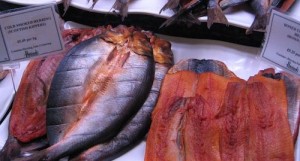Follow That Fish: How to Drop Red Herrings in Your Stories
Some time ago, I wrote a blog post about a trope known as Chekhov’s Gun, a literary device in which a seemingly unimportant detail later becomes significant to the plot. But what if you want to achieve the opposite effect, that is, introduce a supposedly important detail that later turns out to have little or nothing to do with the main story? Today’s post features a sister trope that’s equally useful and just as fun to write. Do you enjoy misleading your readers with deceptive clues? Then let me introduce you to the next handy tool in your arsenal: the Red Herring.
Herring? Where?

The “red herring” is a type of heavily cured/smoked kipper. The idiom may have originated from anecdotes relating its use as a tool for misleading hunting dogs.
(CC Image by misocrazy via Flickr)
The Red Herring is a common device in fiction, employed by writers who like to keep readers on their toes. Simply put, it’s a clue intended to lead in the wrong direction. This is an especially useful trope for plots that involve a lot of mystery, as misleading details help to keep the element of surprise. After all, a story in which the major secret is easy to deduce from the beginning isn’t really worth the read, is it?
Like the Chekhov’s Gun, a Red Herring generally relies on the principle of conservation of detail to work properly: every detail presented in a story must have a reason for being there, otherwise it should be discarded. Of course, as mentioned above, a Red Herring functions in the opposite manner as a Chekhov’s Gun in that it’s intended to seem important upon its introduction but is later revealed to have been a distraction from the true secret of the story. The challenge for the audience is trying to tell the fake clues from the real ones!
Placing a Red Herring
Although every Red Herring is purposely used to throw the audience off, the best ones still have some significant connection to the plot even after being revealed as false leads. For instance, a clue can be introduced to set up suspicions about a certain character. This character may later turn out to be innocent, but the clue that seemed to be pointing to them justifies another character as the culprit instead. The example provided on TV Tropes is that of suspects in a hypothetical murder case, but I suppose it could apply to any kind of mystery. The only limit is your own imagination!
For writers who like to get really creative, Red Herrings come in different “flavors”. Subtropes include the Red Herring Shirt, when someone in the background turns out to be an important character; the Red Herring Mole, when a character who seems suspicious turns out to be innocent; and the Red Herring Twist, when a detail played as a potential Chekhov’s Gun turns out to be nothing more than a distraction from the main plot. It’s also possible to create a similar effect with a mistake as opposed to intentional misdirection, while a plot twist confused for a Red Herring due to its overly obvious nature is known as an Untwist.
Overall, I find Red Herrings very enjoyable to write, for when placed well, they can definitely add some interesting twists to a story. Have fun trying them out for yourself, and good luck throwing your readers off with misleading clues!


Recent Comments